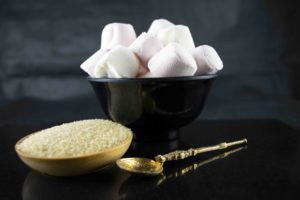Gourmet Marshmallows
For a number of years we ran a successful handmade gourmet confectionery company called Miss Marshmallow Confectionery. This is the recipe that we used to make our gourmet marshmallows. This recipe was perfected over a number of years and we made hundreds of batches of gourmet marshmallows in some twenty different flavours, which we sold at food festivals and over the internet.

This is a professional recipe, so will need to be adapted for home use.
The ingredients
Having a basic understanding how each of the ingredients affects how your gourmet marshmallows will look, taste and their shelf life, is helpful, if you intend to make these marshmallows professionally.
Sugar:
This is the common name for Sucrose. Sucrose has a tendency to crystallise at high concentrations, and will therefore affect the shelf life of your marshmallows. The ability to control this tendency is fundamental to successfully making marshmallows professionally. If your gourmet marshmallows are not to crystallise, then a ” doctoring” agent will need to be added to the ingredient list. A common doctoring agent is Glucose syrup.
Glucose Syrup:
Now this is a very complicated subject!. Glucose syrup is made from the hydrolysis of edible starch. The difference between American and European glucose is that most American glucoses are made from cornstarch, and are therefore known as corn syrup, while in Europe they are made from wheat or potato starch. The main factor in deciding what glucose to use is it’s DE or dextrose equivalent. This is the specification that is used to describe how much the starch molecule has been broken down into simpler sugars. The most common DE to use in this instance is 42DE. There are other DE’s such as 27DE and 63DE, each with its own degrees of viscosity, reactivity, sweetness etc. Glucose syrup is much less sweet than sucrose. So not only will it help to stop the crystallisation of the sucrose, but it will also help reduce the sweetness on the marshmallows.
Invert sugar:
This is another doctoring agent, and is commonly known as a humectant, this means it stops the marshmallows from drying out. It also aids flavour release, and tenderness of the product. Honey is also an invert sugar,however it has a flavour, so is generally not suitable for use in marshmallows. Invert sugar is sweeter than Sucrose.
Dextrose:
With its pleasant, clean and sweet, cooling taste, dextrose is used as a sweetener. Dextrose gives you marshmallows a nice “mouth feel”. Dextrose is one of the sweetest of the starch derived sugars. On a scale on which sucrose is assigned a sweetness value of 100, dextrose is rated at 75. Contrary to sucrose, dextrose is not subject to the process known as inversion, and therefore its degree of sweetness does not change.
Dextrose and sucrose are often used together to control and balance sweetness and total solids. Dextrose will help make your marshmallows less sweet.
Gelatine:
This is a very important part of this recipe. We used 240 Bloom Pork gelatine for this recipe, however you could use Beef, Fish or Chicken gelatine. Use of these other gelatines may require you to adjust the levels of glucose in this recipe. We have written extensively about gelatine and how to use it in out other blogs, so please check out these other blogs for more information.
Cornflour:
This is also a complicated subject, however a good cornflour allows you to use less gelatine in the recipe, and is also used to dust the marshmallows when they are been cut.
Release agent:
Some sort of oil based spray on release agent is useful to line the tins you are depositing the Marshmallow mixture into
The Equipment:
Mixer:
This is expensive. You will need a professional standard to make the quantity as set out in this recipe. Do not try and use a home mixer, however good it is. You will burn the motor out. So something like a Hobart mixer or KitchenAid 6.9L professional mixers. You will need to use the whisk attachment. Start whisking at a low speed and then gradually work up to the top speed..
Sugar Thermometer:
A good thermometer is absolutely essential. You cannot make marshmallows without it.
Trays:
This recipe will fill three trays 12cm by 17cm by 2.5cm. We found metal trays were best.
Pots:
A very large pot is essential.The sugar mixture will froth up, so something in the range of 20l or so would do.
Scales:
A good set of scales that can measure upto 5kg’s is essential
Guitar Cutter:
This is another expensive item, and although marshmallows can be cut by hand, if you are intending to make large numbers of batches regularly, then a guitar cutter is a must. We used a guitar cutter with a 22mm width cut.
Miscellaneous:
Jugs, spoons, bowls and some food safe plastic containers.
The Flavours:
You can flavour marshmallows with just about anything, however we always used the very best natural flavours and colourings. So no artificial flavours or colourings.
We used the best quality vanilla paste, the best quality chocolate and good coffee, for our gourmet marshmallows. We boiled and juiced local Raspberries, Blackcurrants, Blackberries and Strawberries for our fruit flavours, We boiled down the juice and zest of Limes and Lemons for our citrus marshmallows. I’m sure you’re getting the picture.
The recipe:
This recipe is for Madagascan Vanilla marshmallows:
Sugar (sucrose): 400g
Invert Sugar: 400g
Dextrose: 900g
Glucose Syrup: 300g
Water: 300g
Gelatine: 80g
Water (for gelatine): 400g
Cornflour (starch): 48g
Vanilla Paste: 80g
Cornflour (to dust marshmallows)
Method:
A word of caution. You are dealing with very hot liquid sugar, which can cause severe and painful burns, Take extreme care when you are attempting this recipe. Even a drop of the liquid sugar on your skin will be very painful
Coat trays with release emulsion
Mix sugar, invert sugar, dextrose, glucose, starch and 300g of water in a large pot.
Mix gelatine powder with 400g of water,in a jug, and set aside for at least 30 minutes, so the gelatine can bloom (see my post on blooming gelatine.
Measure Vanilla paste out into a bowl.

Bring the sugar mixture in the pot to the boil, and using a sugar thermometer, bring the temp up to 120˚Celsius. The temp of the mixture is critical. If you allow to go to high or not achieve the correct temp, your marshmallows will fail. When it reaches 120˚C take it off the heat and allow the mixture to cool to 100˚C
Just before the sugar mixture comes to 100˚C, heat the bloomed gelatine in a bain-marie or microwave until it is a very warm liquid. Do not allow it to boil. See my post on blooming gelatine.
When the sugar mixture has reached 100˚C, combine it with the liquid gelatine and the vanilla paste in a planetary mixer bowl and whisk, starting at a lowish speed but quickly bringing up to max speed. (take great care as the hot liquid is inclined to splash). Once it is mixed, the marshmallow mixture should expand to fill a 6.9L planetary mixer bowl to the brim.
Pour into the prepared trays, cover and set aside for at least 12 hours. Do not place in a fridge.
Cutting the Marshmallows:
After 12 hours empty the trays out into containers containing a generous amount of cornflour. The marshmallow mixture is very sticky so don’t touch it until it has been dusted with cornflour. Once dusted cut on a guitar cutter or with a knife and dust well in the cornflour. Shake well to remove excess cornflour.
If sealed in airtight bags these gourmet marshmallows should last approx 6 weeks.
